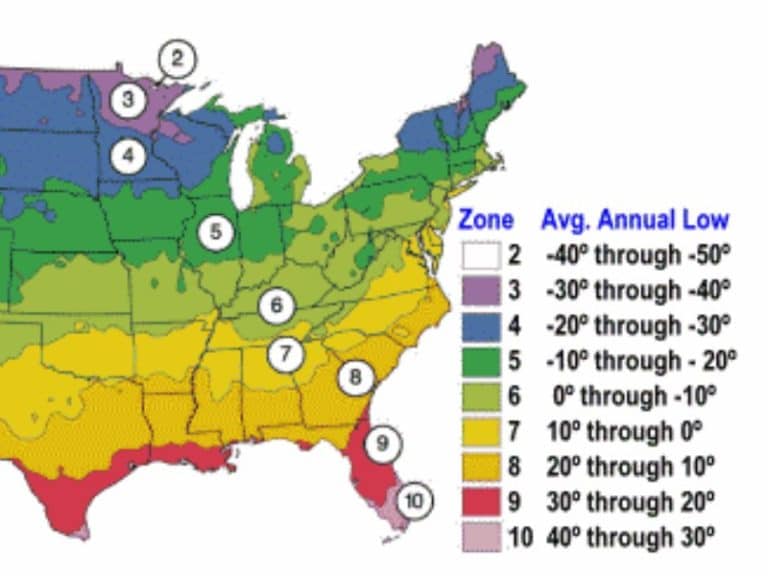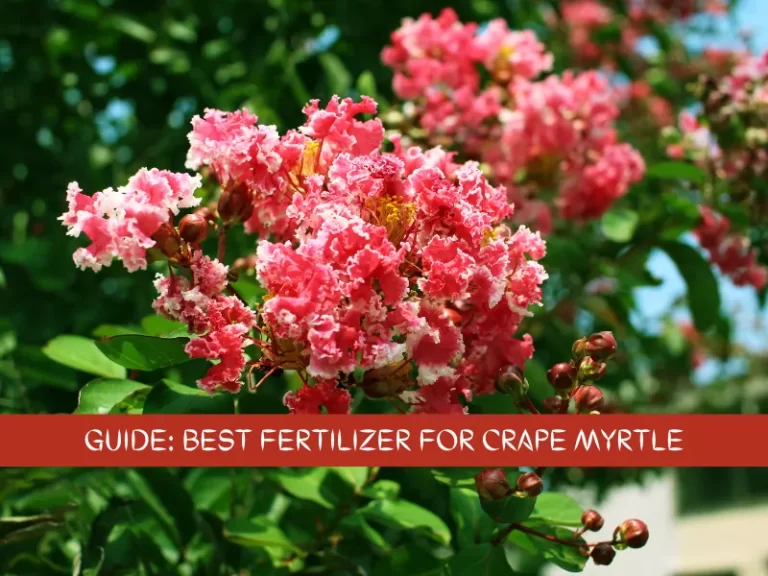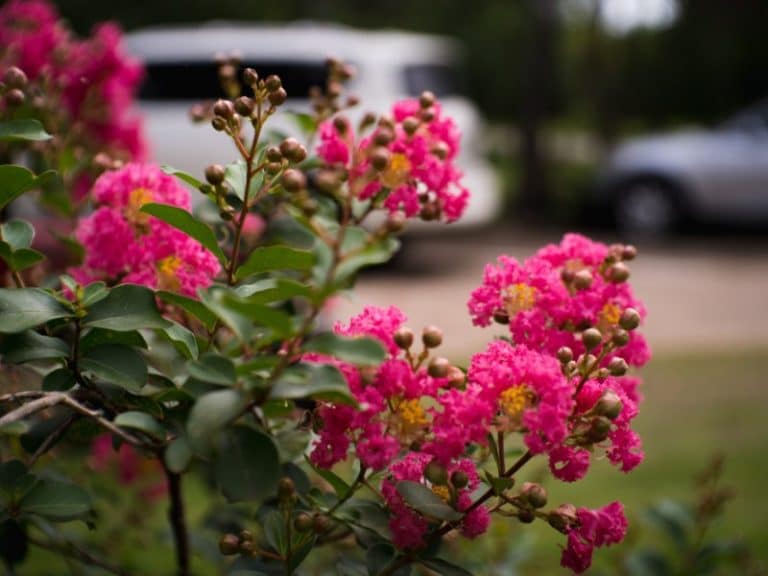Crape Myrtle Bark Scale: Causes, Signs + Treatment
Crape myrtles are prone to growths, diseases, and some pests. A common problem affecting these trees is crape myrtle bark scale, an insect that patches on its bark, diminishing the tree’s aesthetic appeal. What does it look like and how do you get rid of it?
Crape myrtle bark scale appears as black soot near pruning sites or on the trunks of old wood. It progresses to a white crust. It is caused by the crape myrtle bark scale insect that releases honeydew on the tree’s bark. You can treat the tree using soapy water and dormant oil.
Treat heavy infestation with a systemic insecticide such as imidacloprid on the foliage and stem. I’ve elaborated further on the identification, causes, and the best ways to get rid of bark scale on your crape myrtles in the rest of the article.
What does crape myrtle bark scale look like?
Crape myrtle bark scale is a tiny, white/grey pest that appears as an encrusted coating on the bark of crape myrtle trees. During the early stages of infestation, you’ll notice black sooty mold on the tree bark and branches as the nymphs produce honeydew that attracts black mold. When you crush crape myrtle bark scale, it releases a pink liquid with blood-like consistency.
Note: The sooty mold often leads to crape myrtle bark scale being mistaken for aphids, as they both produce honeydew that encourages the growth of black mold. However, crape myrtle bark scale has a distinctive ‘pink blood’ when crushed.
Upon closer inspection using magnifying lenses, you’ll notice these tiny insects are about 2mm long. You may also notice numerous pink eggs. Crape myrtle bark scale also prefers encrusting the lower side of young lateral shoots over the side directly exposed to the sun.
Note: Crape myrtle bark scale mildly resembles mealybugs.
Causes of bark scale on crape myrtle
Crape myrtle bark scale is a common pest on landscape plants like crape myrtle, pomegranate, and boxwood. As such, it’s challenging to avoid infestation. However, infestations are likely more frequent and severe if your crape myrtle trees suffer from natural stressors. These could be due to a lack of water or nutrients or failure to mulch or prune the trees to boost their health.
The limited number of natural predators is another reason why crape myrtle bark scale can infest crape myrtle trees. This pest is native to China. They don’t have many native predators in the US. The lady beetle species that feed on crape myrtle bark scale grow and populate slower than the pest, resulting in ineffective biological control.
Crape Myrtle trees with significant damage are also more vulnerable to crape myrtle bark scale infestation, as the ‘wounds’ provide easy access for the pests. It’s not uncommon to find crape myrtle trees with pruning wounds or injury with higher populations of crape myrtle bark scale than those with little to no damage.
How to get rid of bark scale on crape myrtle
Getting rid of the bark scale on crape myrtle depends on the infestation’s severity and first sighting. Monitoring your plants gives you an upper hand so you can apply preventative measures.
To get rid of bark scale on crape myrtle, you can dislodge them off the tree using a dish soap solution, kill them using a systemic insecticide or a contact pesticide mix.
Wash off the scales
The simplest way to control crape myrtle bark scale is by washing them off the tree’s bark and twigs using a dish soap and water solution. This solution will dislodge most of the adult female scales and eggs off the crape myrtle and wash off the black mold. After preparing the solution, apply by dipping a soft-bristle brush into it and then scrubbing the branches.
Alternatively, a high-pressure hose can wash off the scale and soot. Stick to the proper pressure setting, though, as you don’t want physically damage your crape myrtle tree.
That being said, manually washing off the scales is not the most effective way of getting rid of myrtle tree bark scale, especially in situations where the infestation is severe. Use it as a first step to more effective treatment later.
Spray the crape myrtle with systemic insecticides
Applying a systemic insecticide is the most effective way to get rid of crape myrtle bark scale on landscape plants. For maximum efficacy, they should be drenched or injected into the root zone of the crape myrtle trees. The best systemic insecticides for this species of scale insect contain the following primary active ingredients.
- Clothianidin
- Imidacloprid
- Dinotefuran
- Thiamethoxam
When using a soil-drench systemic herbicide, apply it within the drip line of the crape myrtle tree. The drip line is the area from the outer circumference of the branches moving onward towards the trunk. The drip line is where the crape myrtle feeder roots are located.
However, this method can be slow, as the insecticide takes several weeks to be transferred throughout the tree after drenching. A single application of systemic insecticides will continue to keep crape myrtle bark scale away from your crape myrtle trees for up to 12 months.
To determine if the treatment is effective, wait 3-4 weeks, then crush some of the adult scales encrusted on the crape myrtle tree bark. If no pink liquid comes out, the chemical control has performed well. However, if you can still spot pink blood after crushing the scales, you may need to switch to a systemic pesticide with a different primary active ingredient.
Spray the crape myrtle with contact insecticides
While systemic insecticides work well for adult crape myrtle back scale, contact insecticides are lethal against young crape myrtle bark scale, also known as crawlers. The best contact pesticides for these crawlers contain a mixture of horticultural oil and a primary active ingredient, Bifenthrin.
Always follow the manufacturers’ mixing guidelines when creating a Bifenthrin/horticultural oil pesticide mix. Generally, the recommended amount of horticultural oil is 2%, about five tablespoons for every gallon of water.
This control method is best used from late April to May and in late summer when immature crape myrtle bark scale show up. Horticultural oil treatments are best applied when the temperature is between 45°F and 90°F.
Contact insecticides are applied by spraying directly to the plant’s foliage, branches, and trunk bark. You’ll get the best results if you apply the insecticide in the late evening and when there is no rainfall forecast within the next 24 hours. The timing ensures the insecticide doesn’t dry up quickly due to the hot daytime sun or get washed off too soon by rainfall.
Longer the contact time makes the pesticide treatment more effective
Introduce natural predators
Several species of lady beetles feed on crape myrtle bark scale. Apart from lady beetles, other natural predators that feed on crape myrtle bark scale include 16 species of parasitoid wasps and two species of lacewings.
However, introducing natural enemies is arguably the least effective way of getting rid of crape myrtle bark scale. Use it alongside the other types of controls discussed above. This is because most of them grow slower than the scale pests or come in too late into the season once the infestation has spiraled out of control.
Will crape myrtle bark scale kill the tree?
Crape myrtle bark scale doesn’t directly kill crape myrtle, but it feeds on the plant sap, reducing plant health and vigor. Heavy infestation can lead to reduced blooming rates, stunted growth, and branch death.
This pest also diminishes the visual appeal of this ornamental tree as it appears as unsightly white-grey patches on the bark of the crape myrtle. The black, sooty mold that accompanies it isn’t eye-catching either.
The biggest concern with crape myrtle bark scale is the speed at which it spreads. The insect is considered invasive, and it will spread to other trees. In the South, where crape myrtle trees are popular, you’re likely to find a ghastly-looking yard from crape myrtle back scale infestation.
References
- Michael J. Skvarla- Pennsylvania State University Extension: Crape Myrtle Bark Scale
- The University of Arkansas, Division of Agriculture- Research and Extension: Crape Myrtle Bark Scale – What is this white stuff on my crape Myrtle trees?





